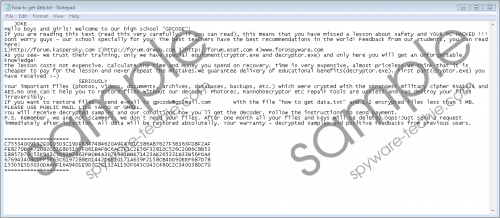Do you know what GPCode Ransomware is?
According to researchers, GPCode Ransomware is an infection targeting users’ personal files primarily because it does not encrypt data stored in the %WINDIR% directory belonging to the operating system. If this computer infection ever finds a way to enter your system too, you will find that it is impossible to open files. Also, you will come across new .txt files GPCode Ransomware creates. No mater a ransomware infection is old or new because all these threats tend to lock files they find stored on the computer and then demand a ransom. Cyber criminals do that because they know that users will not pay money to them if they do not give them the reason to do so. Do not hurry to transfer money to cyber criminals if you have really found your important files encrypted by GPCode Ransomware. It is because you might be fooled again. To be more specific, there are many cases when users send the required money to get the decryption key but get nothing in exchange. Unfortunately, a free tool for unlocking files does not exist. In other words, it might be impossible to get files back if you make a decision not to pay money. Of course, it does not mean that you are encouraged to purchase the key cyber criminals claim to have.
GPCode Ransomware locks files using the RSA-1024 and AES, so that users could not unlock them without the special key. The ransomware infection usually appends the filename extension .LOL!; however, some users say that their personal files encrypted by GPCode Ransomware have an extension .OMG!. It is not hard at all to recognize this ransomware infection even though it might set two different filename extensions. Users quickly notice a new file how to get data.txt containing the ransom note on their Desktops and other directories with encrypted files. It is even placed in %APPDATA%\Microsoft\Windows\Start Menu\Programs\Startup so that it would be automatically opened for users when the Windows OS launches. The ransom note informs users that the system is hacked, and then ask them to send 1-2 files to gpcode@gp2mail.com. You should receive 1-2 decrypted files and instructions on how to make a payment for the decryption tool if you write an email to cyber criminals. It does not mean that you will necessarily get the decryptor and could unlock your files if you transfer the required money. It is up to cyber criminals whether or not to send the decryptor for you, so it might be very true that they will not give you anything in return after receiving what they wanted. GPCode Ransomware screenshot
GPCode Ransomware screenshot
Scroll down for full removal instructions
There is not much users can do to unlock the personal data if they have got infected with GPCode Ransomware but do not wish to pay money to cyber criminals. In fact, only people who have a backup of their files can decrypt files without spending money on the tool cyber criminals have. Every user should keep copies of files on external storage in order not to lose them. Back up your data too in case a similar file-encrypting threats enters the system again.
Let’s talk about the distribution of GPCode Ransomware before we focus on the removal of this computer infection. According to our experts, it is not that easy to point out how this threat has entered the system because there are several different ways ransomware infections are spread. For example, it has been found that GPCode Ransomware might be distributed through the operating system (OS) or Remote Desktop Protocol (RDP) exploits. In addition, it could have entered your computer when you have opened a malicious spam email attachment. Of course, it does not matter now how this threat has appeared on your PC because you still have to delete this threat today.
Let’s make it clear: the personal data encrypted by GPCode Ransomware will not be decrypted if you delete this infection from your system, but you still cannot keep this threat inside your system since it can encrypt your new files again and might not allow you to freely use your computer. Feel free to use our manual removal guide if you are going to get rid of it manually, but do not forget that you have to take care of other untrustworthy programs that might be hiding deep inside your PC as well. In other words, it is highly recommended to scan the system with an automatic malware remover too.
Delete GPCode Ransomware
- Launch Run (Win+R).
- Type %APPDATA%\Microsoft\Windows\Start Menu\Programs\Startup in the box and tap Enter.
- Locate how to get data.txt and remove it.
- Delete this file from other directories you find it in.
- Find and delete the malicious file opened.
- Empty the Recycle bin.
In non-techie terms:
Ransomware infections, just like other malicious applications, are very sneaky threats, so it is not always that easy to prevent them from entering the system. Since it might be very hard to do that alone, the installation of a reputable antimalware tool on the computer would be a smart decision. Our security experts recommend installing SpyHunter to ensure the maximum protection.
